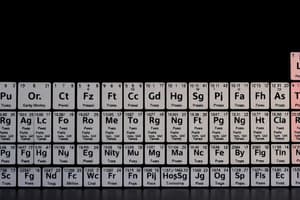Podcast
Questions and Answers
What is the principal quantum number, n, used to represent?
What is the principal quantum number, n, used to represent?
- The spin of electrons in orbitals
- The main energy levels, or shells, the electrons occupy (correct)
- The orientation of electron subshells
- The subshells of the orbitals
- The shape of the orbital
Which statement about electronegativity is true?
Which statement about electronegativity is true?
- Is a relative value (correct)
- Has units of 10 to 18 kJ/g
- Has a minimum value of 0
- Applies to all elements in all states
Arrange the following elements in order of increasing electron affinity: chlorine, potassium, xenon, oxygen, cesium.
Arrange the following elements in order of increasing electron affinity: chlorine, potassium, xenon, oxygen, cesium.
- I, II, III, V, IV
- III, V, II, IV, I
- III, II, V, IV, I (correct)
- III, II, IV, I, V
Which statement best describes electronegativity trends?
Which statement best describes electronegativity trends?
Why is the potassium atom larger than the krypton atom?
Why is the potassium atom larger than the krypton atom?
Which of the following statements about electron orbitals is true?
Which of the following statements about electron orbitals is true?
What is the correct order of increasing size for the elements: titanium, silicon, thallium, nitrogen?
What is the correct order of increasing size for the elements: titanium, silicon, thallium, nitrogen?
Which statement is true regarding diatomic nitrogen?
Which statement is true regarding diatomic nitrogen?
Which group is known for its reactivity?
Which group is known for its reactivity?
How can a covalent bond be best described?
How can a covalent bond be best described?
Which statement is likely to be true?
Which statement is likely to be true?
Flashcards are hidden until you start studying




